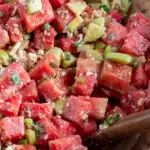Watermelon salad is a refreshing and delicious summer meal perfect for backyard gatherings or as a light and healthy meal option.
Combining the natural sweetness of watermelon with savory and tangy ingredients like balsamic vinegar creates a perfect balance and a delightful flavor combination that will leave your neighbors begging for the recipe.

As summertime brings us the sweetest and juiciest watermelons of the year, you’ll want to save this recipe for your next backyard barbecue or gift it to a neighbor who grows their own! This easy watermelon feta salad goes perfectly with backyard grilling favorites like pork chops and grilled chicken.
How To Cut A Fancy Watermelon
Dicing a small watermelon is a fairly straightforward process. Here’s a step-by-step guide on how to dice a watermelon:
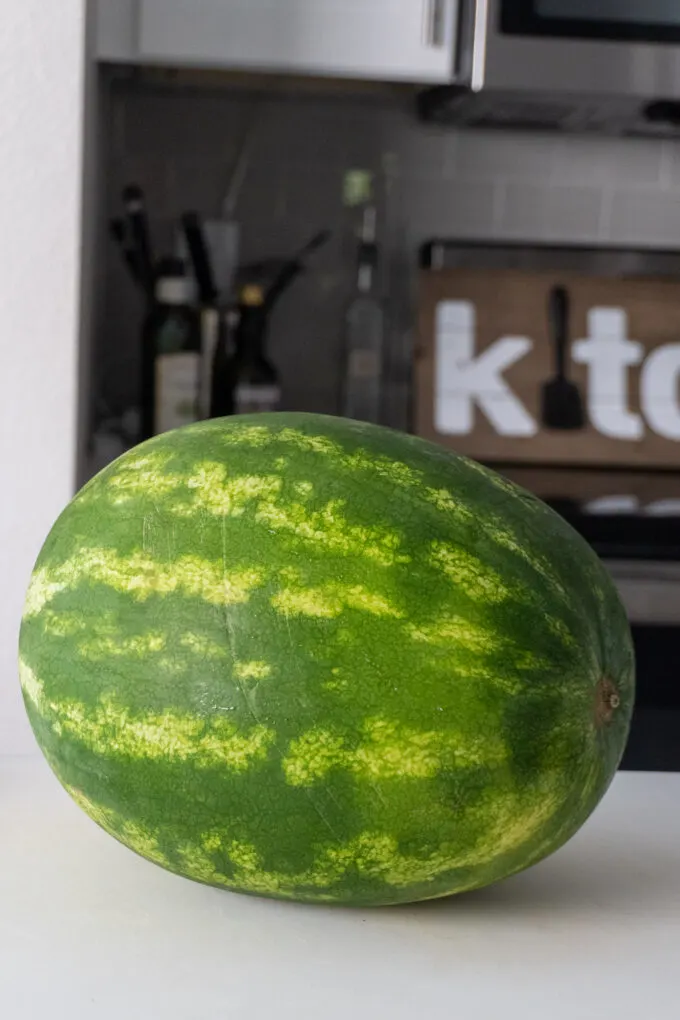
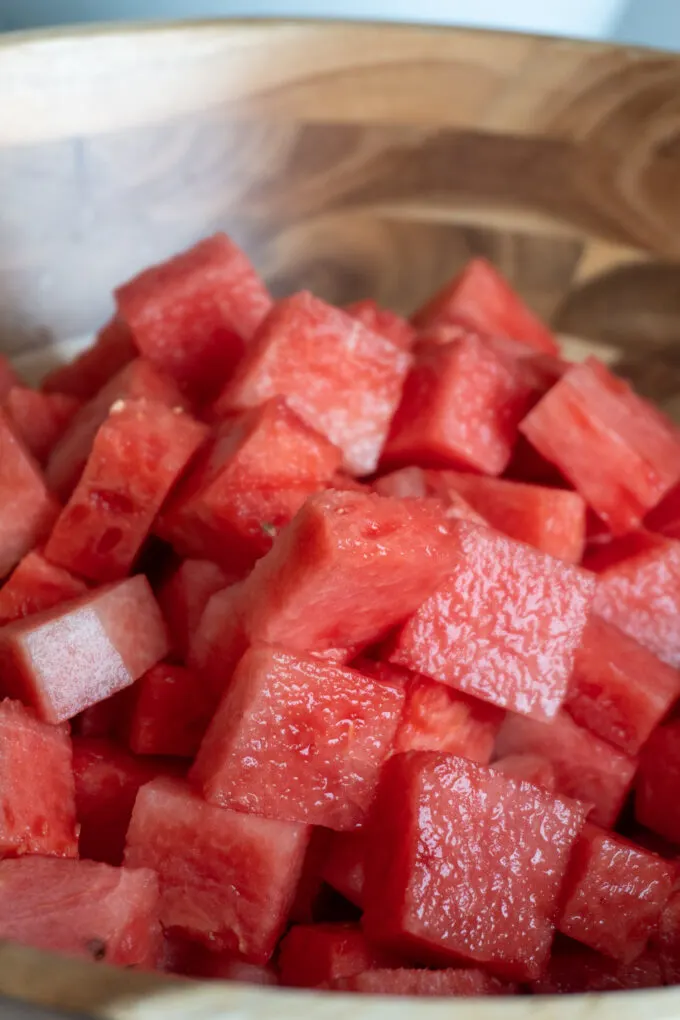
- Choose a ripe watermelon: Look for a watermelon that feels heavy for its size and has a uniform shape. A ripe watermelon will have a deep sound when tapped and a slightly dull surface.
- Wash the watermelon: Before cutting into the watermelon, make sure to wash the outer rind thoroughly under running water to remove any dirt or bacteria that may be present.
- Prepare a cutting surface: Place a cutting board or a clean, sturdy surface on your countertop. I place a wet kitchen rag under my cutting board to prevent it from moving around. It’s important to have a stable surface to ensure safe and efficient cutting.
- Cut off the ends: Using a sharp knife, slice off both ends of the watermelon to create a stable base for cutting.
- Place the watermelon on one end: Stand the watermelon upright on one of the cut ends and carefully slice strips into the rind using a sharp knife. Apply gentle, even pressure to cut through the rind and flesh.
- Rotate: Rotate the watermelon as you go, slicing top to bottom, following the contour of the melon, and removing strips of rind, all the way down to red flesh. Discard these pieces of rind as you go, or compost them.
- Cut the watermelon in half: Hold the now rindless melon and cut down the middle from top to bottom, creating two half moons. Reserve one side in a bowl and prepare to break down the first side. Place the half-moon-shaped watermelon down on its belly with the seeds facing the cutting board and the curve of the watermelon up top.
- Dice the flesh: Cut the half-moon in half and then in half again to create quarters. Take one of the rindless watermelon quarters and cut it into manageable slices. Then, cut those slices into cubes of your desired size. Repeat this process for all the watermelon quarters until you have diced the entire fruit.
- Transfer and serve: Once you have diced the watermelon, transfer the pieces to a serving bowl or airtight container if you’re storing it. It’s best to serve the watermelon soon after dicing to maintain its freshness and juiciness.
Note: When handling a large watermelon, it’s essential to use caution and maintain a firm grip on the fruit and the knife to avoid any accidents. Always keep your fingers away from the path of the blade while cutting.
Can You Compost Watermelon Rind?
Yes, watermelon rinds can be composted. Composting watermelon rinds is a great way to reduce waste and enrich your compost with valuable organic matter. However, watermelon rinds can take a bit longer to decompose compared to other kitchen scraps due to their tougher and fibrous nature.
Cut the rinds into smaller pieces and have patience, periodically mixing the pile. It can take several weeks or months to break down watermelon rind.
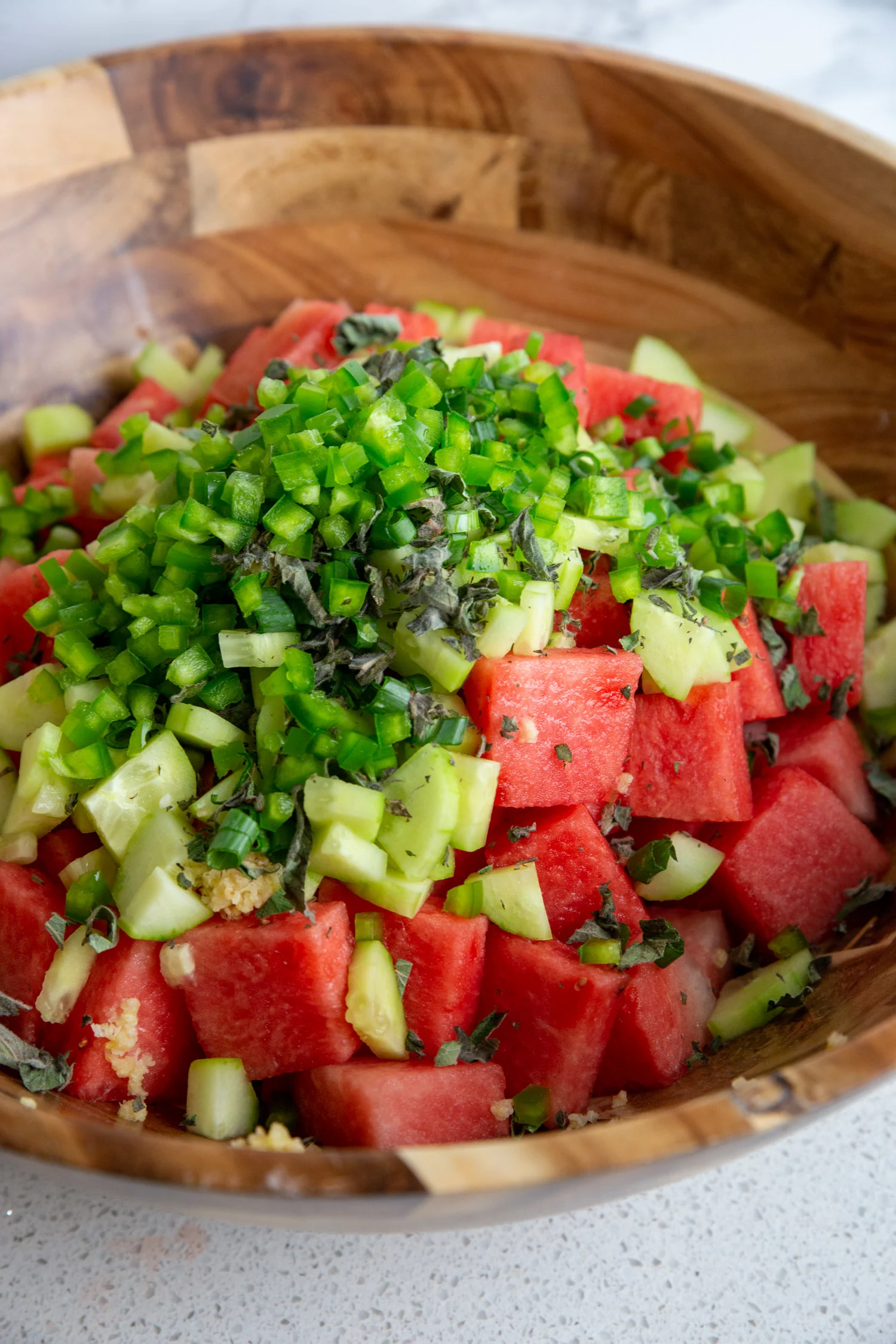
How Long Does Cut Watermelon Last?
Pre-cut watermelon is available in the produce section of the grocery store, but once a watermelon has been cut, its shelf life will be significantly shorter compared to a whole, uncut watermelon. The exact duration can vary depending on factors such as storage conditions, temperature, and overall fruit quality.
Here are some general guidelines for the storage and freshness of cut sweet watermelon:
- Refrigeration: Cut watermelon should be stored in the refrigerator to slow down the process of deterioration. Place the cut watermelon in an airtight container or cover it tightly with plastic wrap. This helps maintain its moisture and prevent it from absorbing odors from other foods in the refrigerator.
- Freshness timeline: On average, cut watermelon can last anywhere from 3 to 5 days in the refrigerator. However, it’s important to note that the sweetness of the watermelon will gradually decline over time. The flesh may become softer, lose its crispness, and the flavor may not be as vibrant. Because of this, use extreme caution that store-bought watermelon has been cut that morning.
- Visual and fragrance cues: To assess the freshness of cut watermelon, look for signs of spoilage such as mold growth, off odors, or significant changes in color and texture. If any of these indicators are present, it’s best to discard the watermelon to avoid the risk of foodborne illness.
- Considerations for optimal freshness: To maximize the lifespan of cut, good watermelon, try to minimize exposure to air and moisture. Cut the watermelon into smaller, manageable portions as needed, rather than slicing the entire fruit at once. Additionally, avoid storing the cut watermelon near strong-smelling foods in the refrigerator, as it can absorb odors.
The freshness of cut watermelon can vary depending on factors specific to each fruit and whether you are purchasing in true watermelon season. Always use your best judgment and rely on visual guides and sensory cues to determine whether the watermelon is still suitable for consumption.
When in doubt, it’s safer to err on the side of caution and discard any cut watermelon that appears spoiled or smells off!
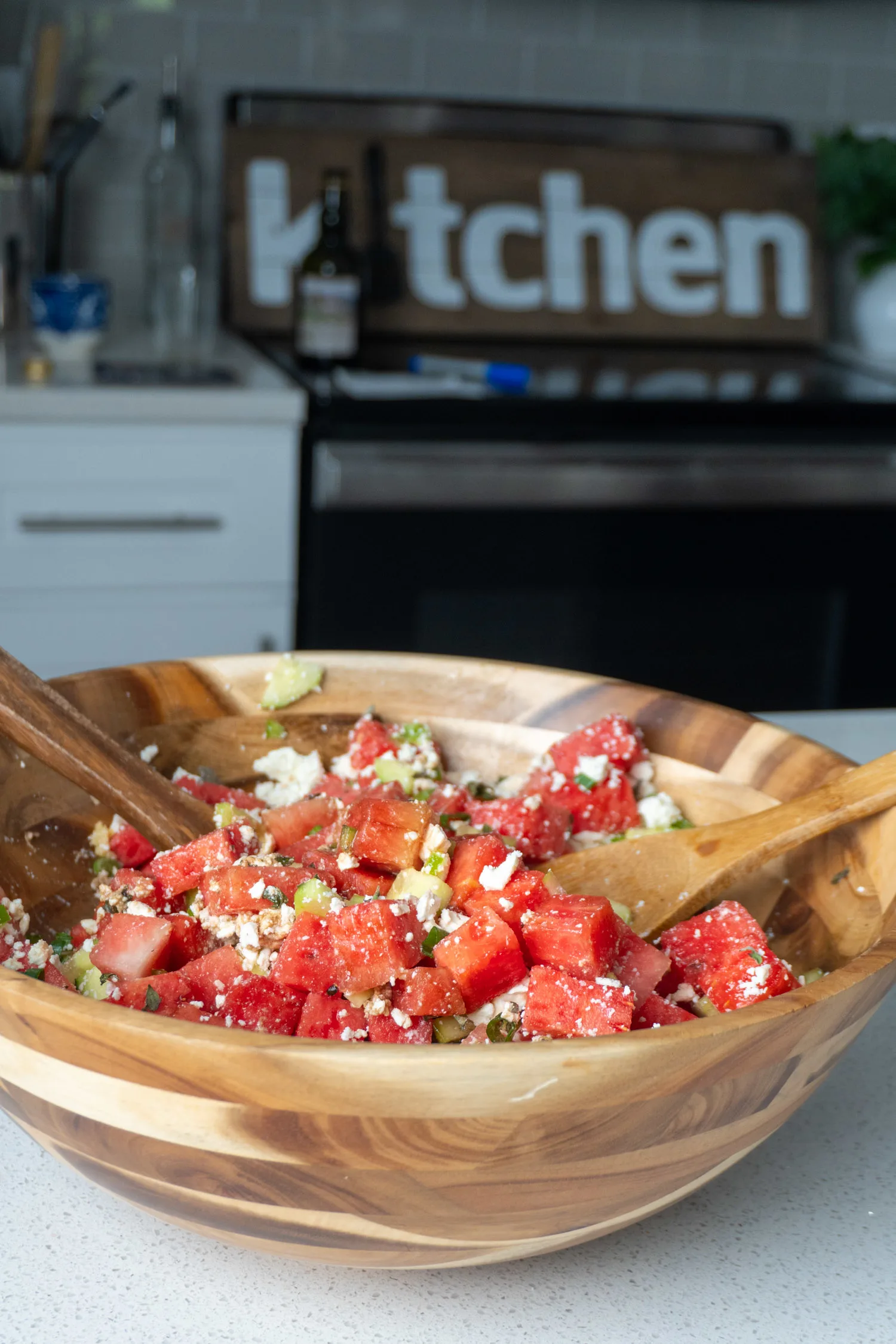
How To Tell If Cut Watermelon Is Bad
When determining if a cut watermelon is bad and no longer suitable for consumption, there are several signs to look out for. Here are some indicators that can help you assess the freshness and safety of cut watermelon:
- Appearance: Inspect the cut surface of the watermelon. If you notice any visible mold, discoloration, or slimy texture, it is likely an indication of spoilage. Mold can appear as fuzzy patches or spots on the flesh, ranging from white to green or black in color.
- Smell: Take a whiff of the cut watermelon. Fresh watermelon has a sweet, pleasant aroma. However, if the watermelon emits a strong, unpleasant, or sour odor, it is a sign of spoilage and bacterial growth.
- Texture: Touch the flesh of the cut watermelon. Fresh watermelon should have a firm and slightly crisp texture. If the flesh feels excessively soft, mushy, or slimy, it indicates that the watermelon has started to break down and is no longer fresh.
- Taste: If the visual and olfactory cues suggest spoilage but you’re still uncertain, you can do a small taste test. However, be cautious as spoiled watermelon can taste off, unpleasant, or have a fermented flavor. If the taste seems unusual or unappetizing, it’s best to discard it.
It’s important to note that cut watermelon has a relatively short shelf life compared to whole watermelon. Even when stored properly in the refrigerator, it will gradually lose its freshness and quality over time.
To minimize the risk of consuming spoiled watermelon, it’s recommended to consume it within 3 to 5 days of cutting.
When in doubt or if you observe any of the above signs of spoilage, it’s safer to discard the cut watermelon to avoid the risk of foodborne illness. It’s always better to prioritize food safety and choose fresh, healthy options for consumption.
How To Tell When Icebox Watermelon Is Ripe
When selecting a watermelon, it’s important to choose one that is ripe and ready to eat. Here are some tips to help you determine if a watermelon is ripe:
- Look for a creamy or yellow spot: On the underside of the watermelon, where it rested on the ground, there should be a creamy or yellow spot. This is known as the “ground spot.” A ripe watermelon will have a fully developed ground spot, indicating that it has had enough time to ripen on the vine. The best watermelon are vine-ripened.
- Check the skin color and texture: The skin of a ripe watermelon should have a dull or matte appearance, rather than a shiny or glossy one. Additionally, the skin should be firm and free of cuts, bruises, or blemishes. A ripe watermelon will typically have a consistent, uniform color, whether it’s dark green, light green, or striped, depending on the variety.
- Tap it: Gently tap the watermelon with the palm of your hand. A ripe watermelon will produce a deep, hollow sound. If the sound is dull or flat, the watermelon may not be ripe yet or may be overripe.
- Pick it up: Lift the watermelon. A ripe watermelon should feel heavy for its size. This is an indication of its high water content and juiciness.
- Examine the shape: Ripe watermelons are usually oval or round in shape, with no irregular or overly elongated contours. Avoid watermelons that have an odd shape or look misshapen, as they may not be fully ripe or could have internal quality issues.
It’s worth noting that these methods can help you make an educated guess about the ripeness of a watermelon, but they are not foolproof.
The best way to ensure a deliciously ripe watermelon is to buy from a reputable source, such as a trusted farmer’s market, where you can ask the seller for guidance or recommendations.
By considering these indicators of ripeness, you can increase your chances of selecting a ripe and flavorful watermelon that is ready to be enjoyed.
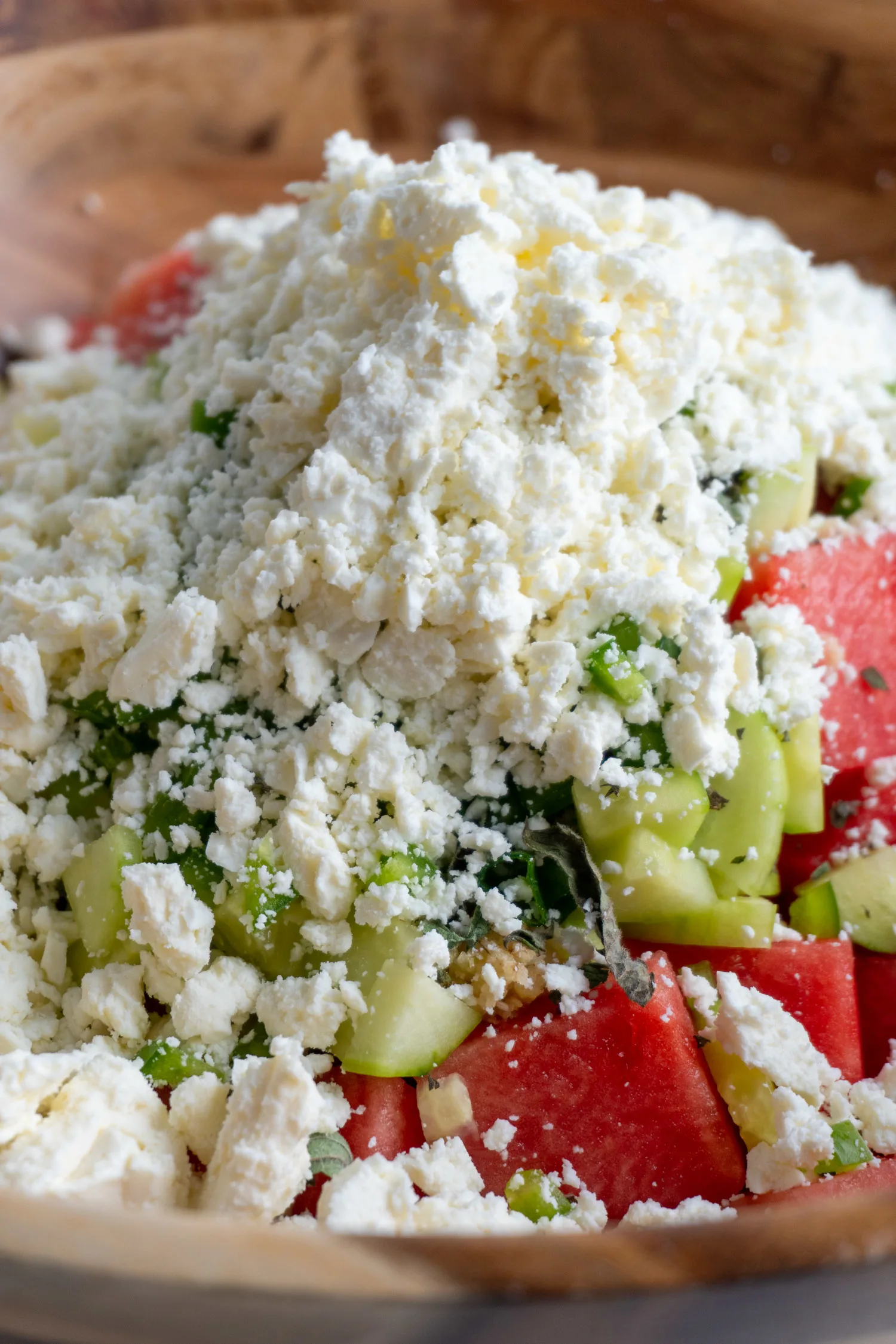
This watermelon feta salad recipe is the perfect summer dish for a hot day by the pool.
Is Overripe Watermelon Safe To Eat?
While overripe watermelon may not be as enjoyable in terms of taste and texture, it is generally safe to eat. However, there are a few things to consider:
- Texture and flavor: Overripe watermelon tends to have a mushy texture and may taste fermented or overly soft. The texture can be unappealing, and the flavor may not be as sweet or refreshing as that of a perfectly ripe watermelon.
- Quality and appearance: Overripe watermelon may exhibit signs of deterioration, such as a wrinkled or saggy skin, mold, or an unpleasant odor. If the watermelon shows significant signs of spoilage, it’s best to discard it to avoid the risk of consuming spoiled fruit.
- Digestive issues: Overripe watermelon, especially if it has started to ferment, may cause digestive discomfort in some individuals. This can include bloating, gas, or an upset stomach. If you have a sensitive stomach or digestive issues, it may be best to avoid eating overripe watermelon.
If you encounter an overripe watermelon, it’s generally safe to consume the flesh that appears and smells fine. However, it’s important to trust your senses and use your judgment.
If the watermelon shows signs of spoilage or an off odor, it’s best to err on the side of caution and discard it, especially given the temperatures of hot summer days.
To avoid wasting watermelon, it’s recommended to store it properly and consume it within a few days of purchase. By paying attention to the signs of ripeness and freshness when selecting a watermelon, you can minimize the chances of encountering an overripe fruit.
What Substitutions Can Be Made In This Watermelon Salad Recipe
- Regular cucumbers or baby cucumbers can be substituted for english cucumbers (you will likely need 2)
- Persian cucumbers are a good substitute.
- Fresh basil can be substituted for fresh mint or other fresh herbs
- If a block of feta cheese is not available, try mild goat cheese
- Balsamic is best but red wine vinegar may be substituted, store-bought balsamic reduction or balsamic glaze is also fine.
- Vegan feta may be used instead of feta cheese, the perfect side dish for your vegan friends
- Regular watermelon can be used instead of seedless watermelon but you will want to gently remove the watermelon seeds and discard them before making this simple salad.
How Can I Prepare The Watermelon Cucumber Salad Ahead?
One of the best ways to prep ahead is to slice the watermelon and cucumber ahead of time. Make the salad dressing and chill. Add all of the final ingredients into smaller bowls, and cover with plastic wrap.
When you’re ready to serve, quickly assemble the salad and toss well. This is one of my favorite ways to bring a covered dish to a potluck or summer event.
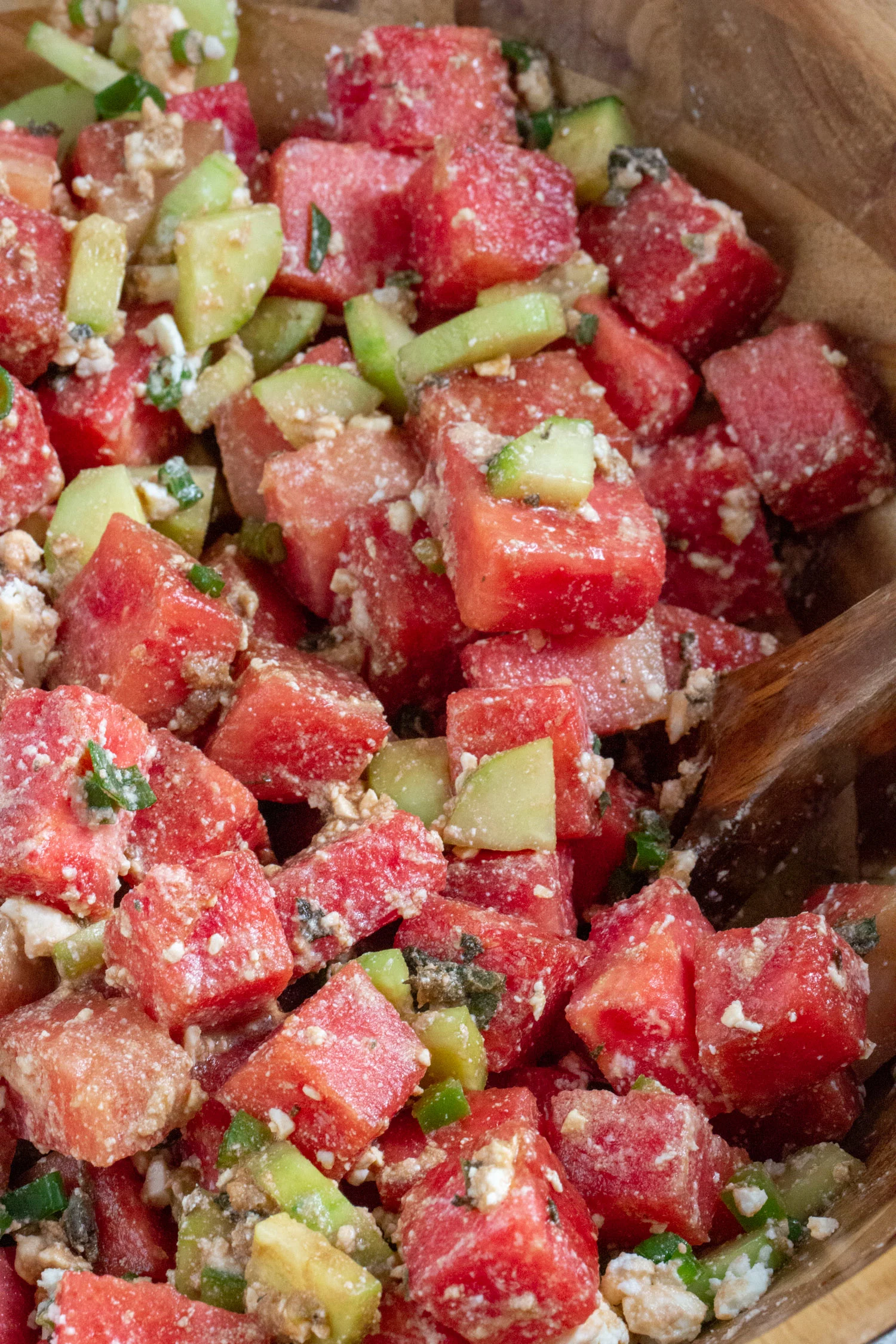
How Long Does Watermelon Salad Last?
Your watermelon salad is best enjoyed immediately after tossing it with the dressing. It can be eaten for an additional 2 days but might not feel quite as fresh.
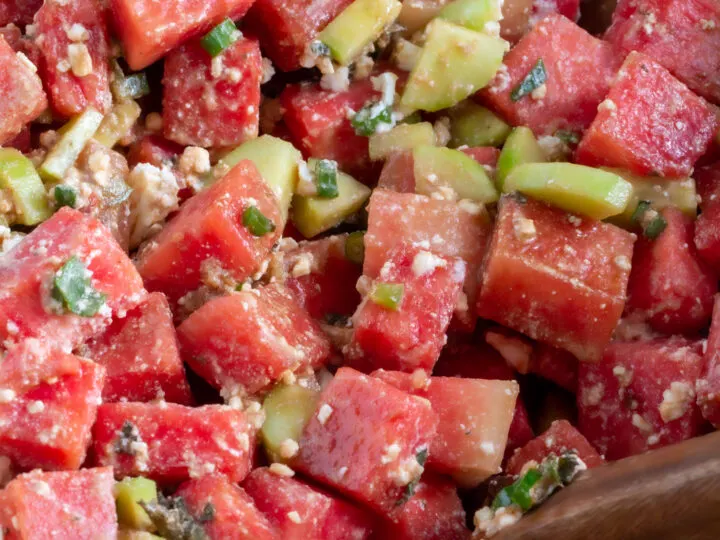
Watermelon Cucumber Salad Recipe
This refreshing sweet watermelon and cucumber salad balanced with tangy balsamic vinegar is the summer side dish that goes with everything! Get the recipe now!
Ingredients
- 4 cups diced watermelon (half a standard-sized seedless watermelon)
- 1 english cucumber (about 2 cups diced)
- 2 garlic cloves, minced
- 1/4 c. fresh mint
- 3 green onions, sliced thin
- 1 jalapeno pepper, seeded and minced
- 3 tablespoons olive oil
- 1/4 c. balsamic vinegar
- 8 oz. fresh feta cheese, crumbled
- sea salt and black pepper to taste
Instructions
Preparing the salad
- In a large bowl, add the diced watermelon cubes (instructions for dicing the watermelon can be found above).
- Wash the english cucumber and peel with a vegetable peeler. Cut the cucumber in half and then into quarters. Slice these quarters thin into small triangles of crisp cucumber and add the cucumber to the watermelon mixture.
- Slice the green onions and seed the jalapeno, mince the jalapeno fine, and add to the bowl.
- Chop up the fresh mint finely, and add to the bowl.
- Crumble the feta cheese and add to the bowl.
- In a small bowl or mason jar, add the minced or crushed garlic, balsamic vinegar, and olive oil. Season with salt and pepper, shake well.
- Pour the dressing all over the juicy watermelon and toss well. Serve this refreshing salad immediately or chill for 1 hour.
Nutrition Information:
Yield:
12Serving Size:
1Amount Per Serving: Calories: 105Total Fat: 8gSaturated Fat: 3gTrans Fat: 0gUnsaturated Fat: 4gCholesterol: 17mgSodium: 201mgCarbohydrates: 7gFiber: 1gSugar: 5gProtein: 3g
This nutritional information is provided as a courtesy as an estimate only. Consult with a dietician for precise estimates. This website makes no claims that the nutritional values listed are accurate.

